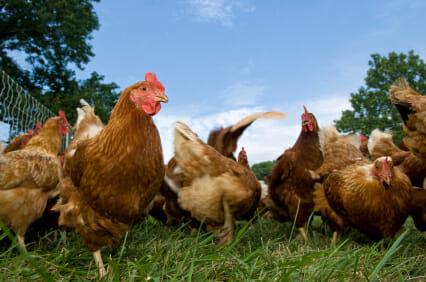 Chicken is one of the healthiest foods you can feed your family, and luckily, one of the easiest to produce as well. Of all the livestock animals, only chickens and rabbits can be raised easily in very small spaces. Chickens are easy to care for and do not have many common health issues. While any research will turn up books or articles outlining the many possible health problems you may have to deal with in chickens, the reality is, most small flock owners will never see most, or even any of them.
Chicken is one of the healthiest foods you can feed your family, and luckily, one of the easiest to produce as well. Of all the livestock animals, only chickens and rabbits can be raised easily in very small spaces. Chickens are easy to care for and do not have many common health issues. While any research will turn up books or articles outlining the many possible health problems you may have to deal with in chickens, the reality is, most small flock owners will never see most, or even any of them.
Chickens are a lot of fun to have around too. Believe it or not, chickens have quite a lot of personality and very humorous characteristics. If you free-range your flock and let them go about their daily meanderings in your yard, they can also provide great benefits to your lawn and garden. They eat grubs and other harmful insects, so your vegetation will look great (although it is a wise choice to keep them out of the garden when it is in production. Chickens love veggies too!)
When you want to raise chickens solely for meat purposes, there are two main points to consider: do you want to breed and raise your own, or do you want to buy chicks and raise them to butchering age without having to keep a year-round flock?
Meat Breeds
If you want to keep a flock of chickens for the purpose of reproducing your meat stock, you will need to select a breed that produces a good amount of meat, while still having the necessary reproduction drive, along with egg-setting drive (broodiness) and ability. Some of the heavier breeds have the breeding instinct at least partially bred out of them, and others are so heavy they do not set on eggs well, or at all.
If you fall in love with a particular “heavy” (as they are usually called), you will need to learn about incubation and obtain the necessary equipment to hatch eggs on your own. This can be quite the project, but fun, educational, and entertaining as well for younger family members.
The best homestead meat chickens, however, are those that have good drive and setting skills. Being self-sufficient is enough work without having to do the animal’s work for them too. The chickens best suited to this duty are not quite as heavy or meaty as bigger breeds. They are very all-around functional. You may have to raise two chicks to butchering age as opposed to one of the heavies, but it will be less work to do it.
Standard meat chickens are usually considered dual purpose. They don’t produce as much meat as the big heavies, nor do they produce as many eggs as the lighter, commercial egg-layers, but they will give homesteaders the greatest variety for the work effort.
One of the more popular meat breeds is the Buff Orpington. This attractive yellow chicken is very hardy and can handle many climates. The Orpington is one of the stock-in-trade animals of the traditional farm homestead. Not only will these chickens produce a fair amount of meat (dress out meat to bone ratio), but you can also collect the eggs you don’t want to hatch for added mealtime enjoyment. There are several other dual purpose breeds that make excellent meat production chickens on the homestead such as Plymouth Rocks, Wyandottes, and New Hampshires.
It is important to choose the breed carefully, however, because some will not get “broody” often, which means they will not set on the eggs, so it’s back to the incubator option. Plymouth Rocks produce a lot of meat, but are not well-known for their broodiness. Orpingtons and Wyandottes are setting champions. They will hatch their own eggs, and care for their chicks
Commercial Meat Production
Even though you are not likely to be interested in producing chicken meat for commercial endeavors, using one of the “meat” breeds as your stock will produce the most pound-for-pound meat for your freezer. These breeds are not really “breeds” at all, but crosses and hybrids, created to have the fastest growth rate, and most meat possible. These chickens are also well-known for their excellent meat quality and taste.
There are many advantages to raising commercial meat stock, but there are also a few disadvantages. It is a good idea to consider the choice carefully and decide what is best for you.
Pros of Commercial Meat Breeds
They grow extremely fast and can make butchering weight in as little as eight weeks. That cuts the workload considerably and you don’t have to feed them as long, so it reduces your feed bill.
The commercial meat breeds produce nearly twice as much meat to bone ratio as a dual purpose chicken.
Cons of the Commercial Meat Breeds
One of the biggest disadvantages of the commercial breeds for use on a small farm or homestead is that because they are hybrids and crosses of chickens that are difficult to breed and hatch out, it is unlikely a typical homestead family will have much success breeding them on their own. That means you will have to buy chicks, and then raise them out. This is still a positive aspect in self-sufficiency because you still know where the food is coming from, what you are feeding, and how it is raised. However it is not 100% self-sufficient because you have to rely on a hatchery to furnish your supply. For busier homesteaders, however, the fact that it isn’t necessary to maintain a full-time flock has great advantages. You only have to work with the chickens for about eight weeks.
Another downside to commercial breeds is that the very speed at which they grow causes deformities, and difficulty standing for young birds. Some breeds actually grow so fast that their legs eventually break from the weight of their bodies when they try to jump down from their roost. It isn’t uncommon to have a 50% loss of stock during the growth period. If you calculate your need for the freezer at about 50 birds per year, you should consider buying 100 chicks. The attrition rate can vary greatly, and newer soluble vitamins used in the water supply help prevent deaths.
The most common and best producing commercial meat breed is the Cornish/Rock. It is a cross between the swift, fast-growing Cornish chicken and the White or Plymouth Rock. These chickens are excellent meat producers with only one purpose in life: to produce large amounts of juicy meat for your table.
Most of the large hatcheries have extensive catalogues on the different breeds, the pros and cons of each breed, and the type of chicken they are (egg layer, dual purpose, or meat). These catalogues are an education in themselves if you’ll study them. Some of the hatcheries include: McMurray Hatchery, Meyer Hatchery, and Stromberg’s. Even if you prefer to buy your chickens from an operation closer to you, requesting a catalogue from these suppliers will help educate you about the different breeds and which ones will be better adapted to your climate and suited to your needs.
_________________________________________________________________
__________________________________________________________________











